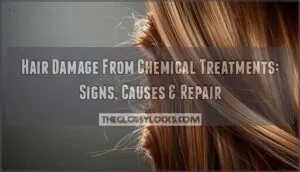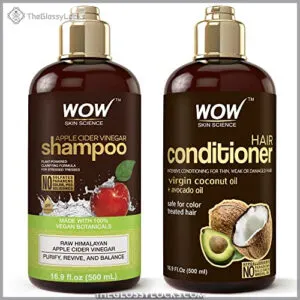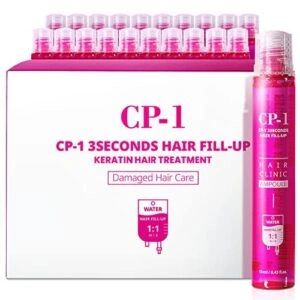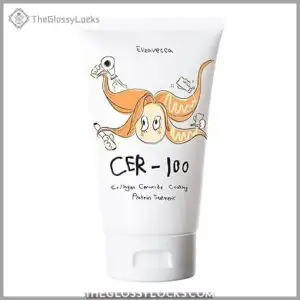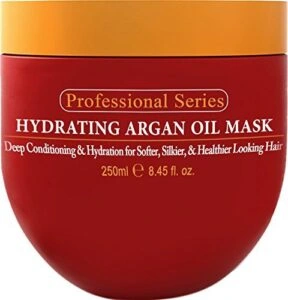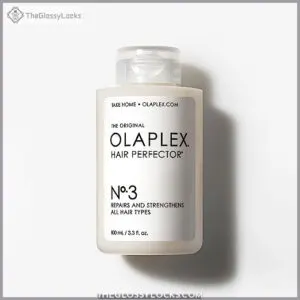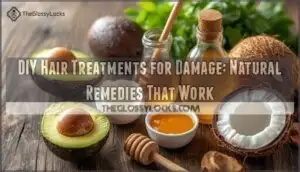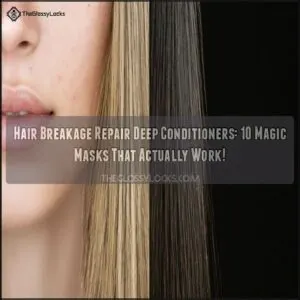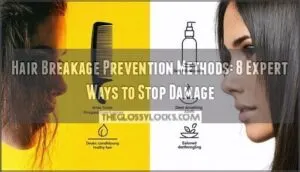This site is supported by our readers. We may earn a commission, at no cost to you, if you purchase through links.
Heat, bleach, dye—the moment they touch your hair, something changes. A sleek new color or smoother texture comes at a price nobody likes to talk about: the hidden scars chemical treatments leave behind. Too often, frayed ends sneak up overnight, strands lose their shine, and a once-supple mane begins to unravel during a routine brush.
Hair damage from chemical treatments isn’t always dramatic or immediate; it can lurk as gradual dryness, tangles that won’t quit, or a persistent frizz that laughs at expensive serums. Understanding what’s at stake reveals not just what goes wrong, but how you can reclaim control and strength, strand by strand.
Table Of Contents
- Key Takeaways
- Signs of Hair Damage From Chemical Treatments
- Common Causes of Chemically Damaged Hair
- Effects of Chemical Treatments on Hair Structure
- Repairing Chemically Damaged Hair
- Best Treatments for Severely Damaged Hair
- Top 5 Products for Chemically Damaged Hair
- Preventing Hair Damage From Chemical Treatments
- Frequently Asked Questions (FAQs)
- Conclusion
Key Takeaways
- Chemical treatments disrupt your hair’s disulfide bonds and cuticle structure, leading to measurable protein loss, increased porosity up to fourfold friction levels, and progressive weakening that compounds with each processing session.
- The most effective repair strategies combine physical intervention (trimming every 6-8 weeks to prevent split end migration) with molecular treatments like bond-building formulas and keratin therapy that actually reconnect broken protein structures rather than just coating damage.
- Waiting four to six weeks between chemical treatments gives your hair essential recovery time for protein rebinding and structural repair, while limiting heat exposure and adopting consistent deep conditioning routines prevents cumulative damage that leads to irreversible thinning.
- Scalp health directly impacts hair recovery from chemical damage—targeted scalp massage, gentle exfoliation to restore microbiome balance, and pH-balancing treatments like diluted apple cider vinegar rinses create the foundation for stronger regrowth and improved strand resilience.
Signs of Hair Damage From Chemical Treatments
Chemical treatments can compromise your hair’s structural integrity in ways that aren’t always obvious at first. When the protein bonds and cuticle layers become damaged, your hair sends clear distress signals that are easy to spot once you know what to look for.
Here are the most common signs that chemical processing has taken a toll on your strands.
Hair Breakage and Split Ends
You’ll spot chemical breakage and split ends fast—they’re your hair’s distress signals. When bleach or dye disrupts those disulfide bonds, protein loss follows. Nearly 40% of people getting chemical treatments see clinical hair breakage. Bleaching agents oxidize the hair shaft, leading to this damage.
- Strands snap under the slightest tension
- Ends fray and split vertically up the shaft
- Fine cracks appear before visible splitting
- Damage compounds with every treatment session
These biomechanical findings don’t lie—chemically damaged hair loses structural integrity you can’t ignore.
Dryness, Dullness, and Frizz
After breakage, you’ll likely notice post-treatment dryness creeping in—hair feels brittle, lacks moisture retention, and the loss of shine is obvious. Frizz causes chaos, especially after chemical damage: cuticle surface changes scatter light and roughen texture.
Chemically damaged hair often looks dull and lifeless, with dryness and frizz sticking around long after the salon chair. Bleaching can increase hair’s wettability properties due to the loss of hydrophobic lipids.
Increased Tangling and Rough Texture
Once dryness sets in, you’ll notice your hair tangling far more than before. Chemical damage cranks up friction and alters surface chemistry, leaving you with rough texture and manageability problems.
Microscopic degradation—think torn cuticles and exposed cortex—makes every brush a battle. The quantitative impact? Up to a fourfold friction increase, so knots and snarls become daily annoyances.
Hair Loss and Thinning
When tangles become routine, it’s easy to miss the bigger threat: chemical-induced hair loss. Chemical Alopecia creeps in fast—sometimes weeks after bleaching or relaxing—leaving you with thinning that feels both unpredictable and unfair.
Beyond the mirror, the financial burden and psychosocial impact of hair loss treatment options can weigh heavy. Fortunately, with proper care, treatment reversibility is often possible.
Common Causes of Chemically Damaged Hair
Chemical treatments can leave your hair vulnerable in more ways than one. If you’ve noticed your hair losing strength or shine, it’s worth knowing what might be behind it.
Here are the most common culprits regarding chemical damage.
Hair Coloring and Bleaching
Ever wondered why your hair feels brittle after coloring? Dye Damage and Bleach Effects go deeper than you think—chemical damage from hair coloring and bleaching dissolves melanin, ramps up porosity, and weakens fibers.
That’s not just a cosmetic issue; Color Risks include heavy metals and increased breakage. Chemically damaged hair quickly loses strength, shine, and resilience, especially after repeated dye cycles.
Perms and Relaxers
Perms and relaxers are double-edged swords—transforming texture but leaving chemically damaged hair in their wake. Chemical relaxers disrupt keratin bonds, causing perm damage and chemical-induced hair loss. Chemical burns and scalp pain are real relaxer risks. Hair relaxation isn’t gentle; it can trigger eczema, scalp irritation, and structural weakening.
- Chemical Burns
- Perm Damage
- Relaxer Risks
- Hair Texturizing
- Chemical Induced Hair Loss
Heat Styling After Chemical Treatments
Frequently, heat styling on chemically treated hair is a recipe for disaster. Styling tools crank up chemical reactions, amplifying hair porosity and breakage.
Wet strands plus straighteners? That’s a fast track to structural damage. Damaged hair needs thermal protection—without a solid heat protectant, you’re just fueling heat damage.
If you crave control, rethink your styling habits before your hair rebels.
Skipping Regular Hair Trims
Neglecting regular trims is like ignoring a warning light on your dashboard—problems build under the surface. Chemically damaged hair demands consistent Split End Prevention to stay ahead of breakage and frizz. Set your Trim Schedules for every 6–8 weeks for real Damage Mitigation:
- Prevent split ends from traveling.
- Reduce hair breakage.
- Improve frizz control.
- Preserve overall hair health.
Effects of Chemical Treatments on Hair Structure
Chemical treatments can shake up more than just your look—they actually change the inner workings of each strand. What happens inside your hair when you color, bleach, or perm makes all the difference in how it feels and behaves.
Here’s a closer look at exactly how these processes leave their mark on your hair’s structure.
Cuticle Damage and Porosity
Think of your hair cuticle as armor—chemical treatments crack this shield, exposing your hair’s nerve center to the world. Chemically damaged hair, with splintered cuticles, sees a spike in hair porosity and frizz. This leaves hair limp and fragile, undermining hair elasticity and moisture balance.
| Factor | Healthy Hair | Chemically Damaged Hair |
|---|---|---|
| Cuticle Barrier | Smooth, intact | Broken, fragmented |
| Porosity | Low | High |
| Frizz Control | Easy | Challenging |
Loss of Moisture and Natural Oils
Ever notice how chemically damaged hair can feel like straw, no matter what you slather on? That’s your hair’s cry for moisture balance. Bleaching and coloring gouge out natural oils and lipids, slamming the door on hydration.
The result? Hair dryness, high porosity, stubborn roughness. Recovering takes patience: think cuticle repair, oil restoration, and targeted moisture treatments for real lipid replenishment.
Weakening of Hair Shaft Proteins
When hair’s natural oils vanish, protein fragmentation rushes in. Chemical damage cleaves disulfide bonds and unravels keratin deep in the hair cortex, leaving the shaft hollow and weak. Imagine this:
- The hair shaft becomes fragile, splintered inside.
- Protein oxidation leaves keratin damaged and brittle.
- Structural gaps spread—making hair breakage an everyday reality.
Long-Term Impact on Hair Health
That splintered, hollowed-out shaft isn’t just about weakness—it’s a long-term warning. Chemical accumulation builds up, causing chronic scalp inflammation and follicle damage. Over time, hair loss and thinning become more likely. Even mild hair breakage can lead to permanent changes in hair health.
Chemical build-up weakens your hair long-term, turning subtle breakage into lasting scalp damage and thinning that can be difficult to reverse
Here’s what repeated chemical damage looks like:
| Symptom | Lasting Consequence |
|---|---|
| Scalp redness | Chronic Inflammation |
| Hair thinning | Follicle Damage |
| Split ends | Increased Hair Breakage |
| Brittle roots | Progressive Hair Loss |
Repairing Chemically Damaged Hair
If your hair feels rough, breaks easily, or looks dull after chemical treatments, you’re not alone. Repair is possible with the right strategies and steady care.
Here’s how you can start to restore strength and shine.
Trimming Split Ends
Let’s talk split ends: they’re the silent saboteurs of chemically damaged hair. If you want real Damage Control, regular maintenance is non-negotiable.
Trimming hair every 6–8 weeks isn’t about losing length; it’s about Split End Prevention. Snipping away frayed tips fortifies your strands, enhances shine, and delivers instant hair repair. Trust me—this routine pays dividends.
Deep Conditioning and Hair Masks
Think slashing split ends is your secret weapon? Not quite—deep conditioning and hair masking steal the spotlight for real hair rejuvenation.
Work a rich hair treatment or protein repair mask through your strands weekly. The science backs it: deep conditioners recharge moisture retention, repair damage, and bring parched dull hair back to life.
Hair masking is your shortcut to visible softness and resilience.
Using Leave-in Conditioners
Rescue in a bottle: leave-in conditioners. This isn’t your rinse-and-go routine. Modern leave-in treatments, from classic creams to powerhouse LeaveIn Molecular Hair Masks, drench chemically battered strands in essential hair moisture, fuel damage repair, and outperform standard formulas.
Their barrier effect locks in hydration, boosts elasticity, and delivers reliable hair protection—defense your hair craves between washes, no heavy buildup required.
Reducing Wash Frequency
Sometimes, dialing back your wash frequency feels like a rebellion—but your hair might thank you for it. Overwashing strips much-needed hair oil and moisture, leaving chemically damaged hair brittle.
Still, too few washes can mean product buildup, scalp health issues, and a greasy curtain.
Opt for gentle routines: strike a balance that preserves hair health, prevents breakage, and keeps product overload in check.
Best Treatments for Severely Damaged Hair
When your hair is hanging on by a thread, you need more than just the basics. Let’s look at the most effective ways to truly repair and revive strands that have seen better days.
Here’s what actually works for severely damaged hair.
Keratin and Protein Treatments
Tired of frayed, lifeless hair that feels like it’s been through the wringer? Keratin treatments and protein therapy have your back. Keratin benefits go beyond hair smoothening—they fortify weak strands, boost thickness, and reduce breakage.
Protein treatment is your ally for intensive hair damage repair, but weigh treatment risks carefully; overuse leads to stiffness instead of strength.
Bond-Building Hair Treatments
Ready for advanced hair restoration? Bond-building hair treatments attack chemically damaged hair at the molecular level, physically reconnecting broken bonds and reversing chemical damage.
These Bond Repair methods don’t just patch the surface—they reinforce hair from within, boasting impressive treatment efficacy and measurable gains in strength and elasticity.
Product safety, chemical reversal, and visible hair damage repair put control back in your hands.
Intensive Moisture Treatments
Imagine your hair thirsting for deliverance—intensive moisture treatments are your lifeline. With sophisticated Moisture Lock formulas, these hair masks and deep conditioning rituals deliver Hair Hydration right to the core, tackling frizz, dryness, and Damage Repair.
For chemically damaged hair, look for:
- hyaluronic acid serums
- protein-rich deep conditioners
- emollient-rich hair masks
- heat-activated moisture treatments
Scalp Health and Restoration
What’s brewing beneath the surface matters. When scalp health spirals after chemical assaults, true restoration starts with mindful scalp treatments—think Scalp Massage to wake up dormant Hair Follicles and gentle Scalp Exfoliation to revive Microbiome Balance. Combine prescription support with Natural Remedies to combat hair loss, soothe scalp damage, and reclaim your hair’s resilience from the root up.
| Healing Move | What It Does |
|---|---|
| Scalp Massage | Boosts blood flow, fuels restoration |
| Scalp Exfoliation | Clears buildup, encourages new growth |
Apple Cider Vinegar Rinses
Once your scalp is back online, an apple cider vinegar rinse becomes a stealthy ally for chemically damaged hair. Think of it as a reset button: restoring pH balance, sealing rough cuticles, and washing away buildup that dulls shine. This simple move boosts scalp health and frizz reduction—you’ll notice softer texture and serious shine enhancement after just a few washes.
- Balances pH for resilience
- Repairs cuticles, making strands smoother
- Clears buildup for scalp health
- Reduces frizz for better control
- Boosts shine, restoring vibrancy
Top 5 Products for Chemically Damaged Hair
Choosing the right products can make all the difference when your hair’s been through a lot. Here are five options that are especially effective for chemically damaged hair. Each one is worth a closer look if you’re after healthier, stronger strands.
1. Apple Cider Vinegar Hair Duo
An apple cider vinegar hair duo isn’t just a trend—it’s a targeted defense for chemically damaged hair. This detox formula blends the ACV benefits of pH balancing, clarifying, and high gloss with plant-powered conditioners, restoring shine and tackling chemical damage head-on.
With regular use (once or twice a week), you can expect smoother, healthier strands.
For DIY alternatives, dilute ACV with water, but mind potential risks—overuse can worsen dryness, especially on fragile hair. Choose based on your hair’s needs and your comfort with product suitability.
Best For: Anyone struggling with dandruff, frizz, or scalp buildup who wants cleaner, shinier, more hydrated hair with plant-powered ingredients.
- Gently detoxifies and clarifies for a healthier scalp and more vibrant hair.
- Adds high gloss and softness thanks to antioxidants, coconut, and avocado oils.
- Paraben-free, silicone-free, and sulfate-free, making it ideal for daily use on most hair types.
- Some people may find it drying, especially with frequent use or already dry hair.
- The apple cider vinegar scent may be off-putting for those sensitive to smells.
- Results on hair thickness or growth can take time and may not be the same for everyone.
2. Keratin Hair Repair Treatment Set
Want something that packs a punch for repairing chemically damaged hair? Keratin hair repair treatment sets offer just that—quick bond building, intensive hydration, and measurable hair restoration. The 3-second keratin formula strengthens strands, boosts shine, and noticeably reduces breakage thanks to its powerful protein mask.
Treatment options like this are more than hype; they increase thickness and tensile strength while smoothing the cuticle. If you’re serious about hair damage repair, look for product efficacy measured by both science and your own touch.
Best For: Adults with dry, damaged, or chemically treated hair who want quick, noticeable repair and salon-quality care at home.
- Repairs and strengthens hair, increasing thickness and reducing breakage fast
- Noticeably improves softness, shine, and manageability after a single use
- Convenient single-use ampules make it easy to apply the right amount every time
- The strong scent and need for mixing with water may be off-putting to some users
- Results and effectiveness can vary depending on hair type and condition
- Product may crystallize or be less effective if not used as directed
3. Elizavecca Cer 100 Hair Treatment
Elizavecca Cer 100 Hair Treatment is a go-to for those craving serious Ceramide benefits without breaking the bank. Its formula blends Ceramide 3, hydrolyzed collagen, keratin, and silk proteins, locking moisture deep into brittle hair.
This hair mask leaves damaged, color-treated, or fried strands noticeably softer after just a couple of sessions—most users find weekly treatment frequency is enough. According to Hair Mask Reviews, you’ll get smoother, shinier hair, plus far easier detangling—a user experience worth repeating for sustained hair damage repair.
Best For: Anyone with damaged, dry, or color-treated hair looking for an affordable, fast-acting mask to boost softness, shine, and manageability.
- Noticeably softens and detangles hair after just a few uses.
- Affordable alternative to expensive salon treatments.
- Strengthens, hydrates, and adds bounce without heavy fragrance.
- Contains silicones, which may cause buildup for some hair types.
- Can weigh down very fine hair or make scalp oily if overused.
- Doesn’t repair hair bonds like Olaplex or other patented treatments.
4. Argan Oil Hair Repair Mask
Rich in essential fatty acids and vitamin E, an argan oil hair mask stands out for those chasing deep hair repair and lasting softness. This oil treatment reduces protein loss by up to 43%, protecting your hair from breakage after color or bleach.
The blend of nourishing hair mask ingredients like argan oil, silk amino acids, and glycerin hydrates brittle hair, tames frizz, and restores movement. Apply generously to damp lengths, let it soak in, and watch your hair bounce back, glossier and more resilient.
Best For: Anyone with dry, damaged, or overprocessed hair—especially if it’s color-treated, bleached, or struggles with chronic dryness.
- Deeply hydrates, smooths, and revives even brittle, frizzy hair after chemical processing.
- Noticeably improves softness, manageability, and shine in just a few uses.
- Free of sulfates and parabens, making it gentle enough for sensitive scalps and all hair types.
- Some users find it feels too rich or heavy, especially on fine hair.
- Softness may only last up to three days before needing another treatment.
- Occasional issues with jar packaging or leakage upon delivery.
5. Olaplex No 3 Hair Perfector
Bond-building science meets real-world results in Olaplex No 3 Hair Perfector—a small bottle with a big following among anyone chasing serious hair repair. This formula leans on patented bond-building technology to rebuild broken disulfide bridges, going beyond simple hydration.
For chemically damaged hair, Olaplex Benefits show up quickly: less breakage, restored strength, and shine that lasts beyond your next wash. Used weekly, this hair perfector turns the tide against chemical damage and helps restore your hair’s integrity and bounce.
Best For: People with damaged, color-treated, or chemically processed hair who want quick, visible repair and lasting strength.
- Repairs and strengthens broken hair bonds for noticeable softness and shine.
- Works for all hair types, including color-treated, bleached, and curly textures.
- Lightweight formula leaves no greasy residue and can extend time between washes.
- Small bottle size means frequent repurchasing, especially for long or thick hair.
- Results depend on proper, generous application and may require using with a conditioner.
- Can be pricey for the amount provided; some see only subtle improvement at first.
Preventing Hair Damage From Chemical Treatments
Keeping your hair healthy means making smart choices before and after chemical treatments. With the right habits, you can keep damage at bay and enjoy stronger, softer hair.
Here’s where to start if you want to prevent those common signs of stress and breakage.
Limiting Chemical and Heat Exposure
Dial back the drama—your hair doesn’t need to live on the edge. Limiting chemical damage starts with skipping endless color sessions and letting your hair breathe between heat styling marathons.
Choose heat protection over habit, and stick to monthly Safe Styling to keep chemically damaged hair in check. Hair Preservation thrives on boundaries; Gentle Care is your superpower.
Regular Hair Trims and Gentle Handling
Tough love for chemically damaged hair? Regular hair trimming teamed with gentle combing is your best defense. Chop away split ends before they multiply—breakage reduction starts here. Try these:
- Snip damaged tips routinely
- Use detangling sprays for slip
- Swap brushes for a wide-tooth comb
- Never yank through knots
- Handle wet strands delicately
Those small acts protect hair texture and health.
Adopting a Consistent Hair Care Routine
Ever wonder why some hair rebounds while others never quite recover? It’s all about adopting a consistent hair care routine. Consistent application of hair treatments, smart product selection, hydration focus, and daily scalp massage make damage less likely. When routine becomes ritual, your hair health transforms—and preventing hair damage finally sticks.
| Routine Benefits | How to Start |
|---|---|
| Hydration Focus | Weekly deep conditioner |
| Product Selection | Sulfate-free formulas |
| Scalp Massage | 2–3 minutes daily |
| Consistent Application | Leave-in treatments often |
Frequently Asked Questions (FAQs)
How long should you wait between chemical treatments?
Funny how hair works—while you’re trying to reinvent yourself, your hair demands patience. A solid four to six weeks between chemical treatments gives strands time for Chemical Recovery, Hair Rebinding, and real Damage Prevention, minimizing long-term breakage.
Are natural oils safe to use after chemical treatments?
Yes, hair oils are safe for chemically damaged hair when applied correctly. Coconut, argan, and jojoba oils strengthen damaged strands, but watch for buildup potential and allergy risks—especially with nut-based oils like almond oil.
Is it safe to swim with chemically treated hair?
Swimming can feel freeing, yet it traps chemically damaged hair in a triple threat: chlorine effects strip proteins, saltwater damage causes swelling, and UV exposure accelerates color fading.
Post-swim care and protective measures—like waterproof treatments—are essential.
What are signs of an allergic reaction to hair chemicals?
Allergic reactions to harmful chemicals can trigger facial swelling, eczematous rash, and itching sensations. You might notice skin lesions or distant swelling beyond application sites—all signs of chemically damaged hair requiring immediate attention.
Conclusion
Protect, preserve, and prioritize—your hair won’t fight back alone. Hair damage from chemical treatments doesn’t spell defeat; it signals a turning point where informed choices and targeted repair become your greatest allies.
Whether you’re nursing bleached strands or recovering from relaxers, consistency in conditioning, trimming, and reducing further stress rebuilds resilience strand by strand.
Don’t wait for visible wreckage—start now, adjust your routine, and watch strength return where fragility once lived.
- https://pmc.ncbi.nlm.nih.gov/articles/PMC9921463/
- https://www.sciencedirect.com/science/article/pii/S2405844024139023
- https://theradome.com/blogs/blog/can-bleaching-cause-hair-loss
- https://www.colaz.co.uk/blog/can-hair-dye-cause-hair-loss/
- https://scandinavianbiolabs.com/blogs/hair-growth/how-much-hair-loss-is-normal-after-bleaching-damage-control-and-care

